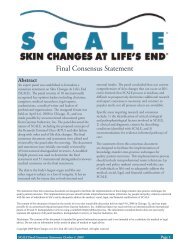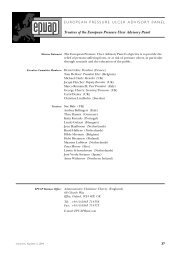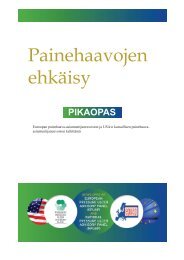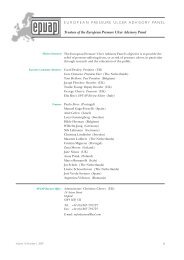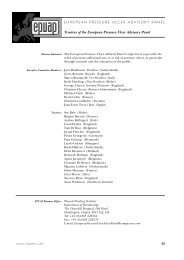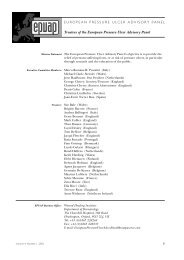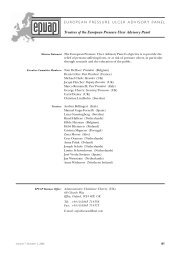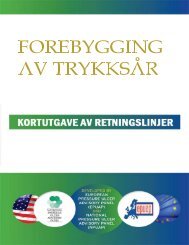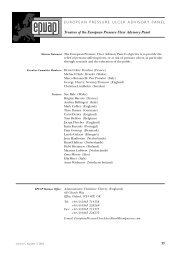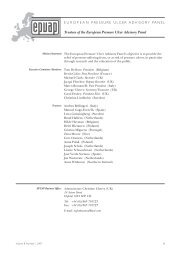EPUAP Review 5/2 RIP - European Pressure Ulcer Advisory Panel
EPUAP Review 5/2 RIP - European Pressure Ulcer Advisory Panel
EPUAP Review 5/2 RIP - European Pressure Ulcer Advisory Panel
Create successful ePaper yourself
Turn your PDF publications into a flip-book with our unique Google optimized e-Paper software.
EUROPEAN PRESSURE ULCER ADVISORY PANEL<br />
Gunther RA, Clark M. The effect of a dynamic pressureredistributing<br />
bed support surface upon systemic lymph<br />
flow and composition. J of Tissue Viability. 2000; 10(3 su):<br />
10–5.<br />
Guralnik JM, Harris TB, White LR, Cornoni-Huntley JC.<br />
Occurrence and predictors of pressure sores in the<br />
National Health and Nutrition Examination Survey<br />
Follow-up. J of the American Geriatrics Society 1988; 36(9):<br />
807–812.<br />
Hale CA, Thomas LH, Bond S, Todd C. The usefulness of<br />
topical application of essential fatty acids (EFA) to<br />
prevent pressure ulcers… based on information<br />
presented during the 1997 Symposium on Advanced<br />
Wound Care & Medical Research Forum on Wound<br />
Repair, April 12–16, 1997 in New Orleans, LA. Ostomy<br />
Wound Management 1997; 43(5): 48–50.<br />
Halfens RJG, Van Achterberg T, Bal RM. Beyond the<br />
pressure ulcer blame game: reflections for the future.<br />
Ostomy Wound Management 2000; 46(5): 46–8.<br />
Halfens RJ, Van Achterberg T, Bal RM. Validity and<br />
reliability of the braden scale and the influence of<br />
other risk factors: a multi-centre prospective study. Int.<br />
J of Nursing Studies. 2000; 37(4): 313–9.<br />
Hanan K, Scheele L. Albumin vs. weight as a predictor of<br />
nutritional status and pressure ulcer development.<br />
Ostomy Wound Management 1991<br />
Happ E, Wind S, Kerstein MD. <strong>Pressure</strong> ulcers: collaboration<br />
in wound care. Is there a reasonable approach?<br />
[corrected] [published erratum appears in Wounds<br />
1997 May–Jun; 9(3): A8]. Wounds A Compendium of<br />
Clinical Research & Practice 1997; 9(2): 34–42.<br />
Hartgrink HH, Wille J, Konig P, Hermans J, Breslau PJ.<br />
<strong>Pressure</strong> sores and tube feeding in patients with a<br />
fracture of the hip: a randomized clinical trial. Clinical<br />
Nutrition. 1998; 17(6): 287–92.<br />
Hasegawa K, Homma S, Kanda K. Effects of vitamin B1, B6<br />
and B12 complex on the regeneration of the peripheral<br />
nerve and muscle receptors. Nippon Yakurigaku<br />
Zasshi – Folia Pharmacologica Japonica. 1973; 69(3): 483–<br />
97.<br />
Haussmann MF, Lay DC, Jr., Buchanan HS, Hopper JG.<br />
Butorphanol tartrate acts to decrease sow activity, which<br />
could lead to reduced pig crushing. J of Animal Science.<br />
1999; 77(8): 2054–9.<br />
Hill DP, Jr., Cooper DM, Robson MC. Serum albumin is a<br />
poor prognostic factor for pressure ulcer healing in<br />
controlled clinical trials. Wounds A Compendium of<br />
Clinical Research & Practice 1994; 6(5): 174–8.<br />
Himes D. Progress in nutrition. Nutritional supplements in<br />
the treatment of pressure ulcers: practical perspectives.<br />
Advances in Wound Care 1997; 10(1): 30–1.<br />
Himes D. <strong>Pressure</strong> sores: hospital’s physicians and nurses<br />
faulted for patient’s care. Legal Eagle Eye Newsletter for the<br />
Nursing Profession 1997; 5(1)<br />
Himes D. Protein-calorie malnutrition and involuntary<br />
weight loss: the role of aggressive nutritional intervention<br />
in wound healing. Ostomy Wound Management 1999;<br />
45(3): 48–51.<br />
Hoffman DR. Factors affecting the predictive validity of the<br />
Braden Scale. Advances in Wound Care 1996; 9(6): 32–6.<br />
Hoffman DR. The False Claims Act as a remedy to the<br />
inadequate provision of nutrition and wound care to<br />
nursing home residents. Advances in Wound Care. 1996;<br />
9(5): 25–9.<br />
58<br />
Hoffman DR. The nursing record as a research tool to<br />
identify nursing interventions. Journal of Clinical Nursing<br />
1997; 6(3): 207–14.<br />
Hofmann-Rosener M. [Decubitus risk scales in comparison].<br />
Krankenpflege Journal. 1994; 32(6): 234–8.<br />
Hofmann-Rosener M. [Prevention of decubitus ulcers].<br />
Pflege Aktuell. 1998; 52(2): 111–5; quiz 116–7.<br />
Holmes R, Macchiano K, Jhangiani SS, Agarwal NR, Savino<br />
JA. Nutrition know-how. Combating pressure sores –<br />
nutritionally. Ajn, American J of Nursing. 1987; 87(10):<br />
1301–3.<br />
Horn SD, Bender SA, Bergstrom N, Cook AS, Ferguson<br />
ML, Rimmasch HL, et al. Description of The National<br />
<strong>Pressure</strong> <strong>Ulcer</strong> Long-Term Care Study. J of the American<br />
Geriatrics Society 2002; 50(11): 1816–1825.<br />
Houwing R, Overgoor M, Kon M, Jansen G, van Asbeck BS,<br />
Haalboom JR. <strong>Pressure</strong>-induced skin lesions in pigs:<br />
reperfusion injury and the effects of vitamin E. J of<br />
Wound Care. 2000; 9(1): 36–40.<br />
Huey FL. What teaching nursing homes are teaching us.<br />
American J of Nursing. 1985; 85(6): 678–83.<br />
Huffines B, Logsdon MC. The Neonatal Skin Risk Assessment<br />
Scale for predicting skin breakdown in neonates.<br />
Issues in Comprehensive Pediatric Nursing. 1997; 20(2):<br />
103–14.<br />
Hurley HJ. Three nursing home patients who, due to<br />
inadequate care and poor nutrition, developed severe<br />
bed sores. Ostomy Wound Management. 1996; 42(3): 4.<br />
Ing TS, Yu AW, Rahman MA. Spinal cord injury and<br />
vitamin D metabolism. J of the American Paraplegia Society.<br />
1993; 16(1): 1–2.<br />
Jackobs MK. The cost of medical nutrition therapy in<br />
healing pressure ulcers. Topics in Clinical Nutrition 1999;<br />
14(2): 41–7.<br />
Jackobs MK. Healing pressure ulcers. Determining the cost<br />
of medical nutrition therapy in long-term care. Health<br />
Care Food & Nutrition Focus. 1999; 15(10): 10–2.<br />
James HM. Does your prevention policy protect? <strong>Pressure</strong><br />
care in acutely ill patients. Professional Nurse. 1994;<br />
10(1): 41–4.<br />
James H. Preventing pressure sores in patients’ homes.<br />
Professional Nurse. 1995; 10(10): 649–50, 652.<br />
James H. Preventing pressure sores in patients’ homes.<br />
Professional Nurse. 1997; 12(6 Suppl): S12–4.<br />
Jastremski CA. <strong>Pressure</strong> relief bedding to prevent pressure<br />
ulcer development in critical care. J of Critical Care.<br />
2002; 17(2): 122–5.<br />
Jaul E. <strong>Pressure</strong> sores unit – a one year study. Harefuah.<br />
2001; 140(10): 903–6, 992, 991.<br />
Jensen TT, Juncker Y. <strong>Pressure</strong> sores common after hip<br />
operations. Acta Orthopaedica Scandinavica. 1987; 58(3):<br />
209–11.<br />
Jeter KF, Lutz JB. Skin care in the frail, elderly, dependent,<br />
incontinent patient. Advances in Wound Care 1996; 9(5<br />
pt. 1): 25–9.<br />
Johnson BG. Nutrition and the decubitus ulcer. Todays<br />
Nursing Home. 1983; 4(2): 36–8.<br />
Judson R. <strong>Pressure</strong> sores. Medical Journal of Australia. 1983;<br />
1(9): 417–22.<br />
Kamata K. Management for the prevention of pressure<br />
sores. Japanese J of Plastic & Reconstructive Surgery 1990;<br />
33(6): 513–520.<br />
Volume 5, Number 2, 2003



